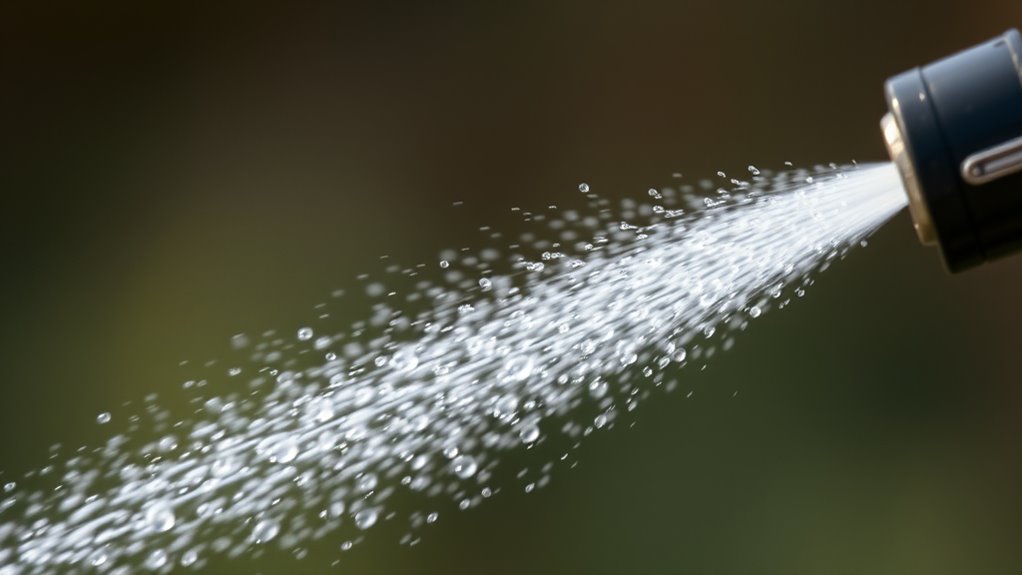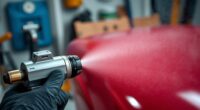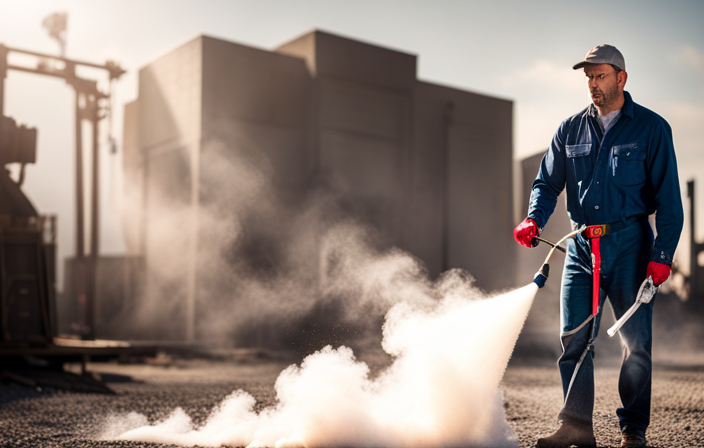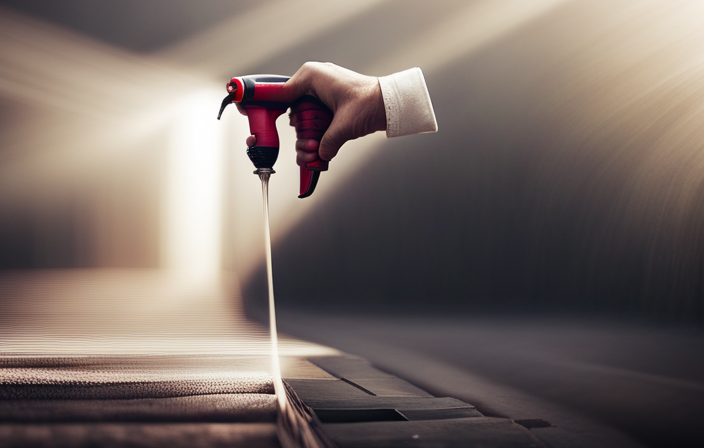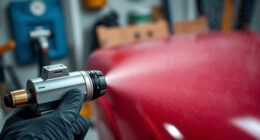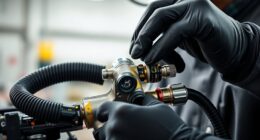To achieve a perfect spray, focus on your distance and angle. Keep the nozzle at an ideal distance—close enough for even coverage but not so close that drips occur. Hold the nozzle perpendicular for uniform application, tilting slightly to adjust coverage as needed. Moving closer produces thicker spray, while stepping back spreads it out more evenly. Adjusting your angle controls spray shape and density. Mastering these simple geometric principles helps you get professional results every time.
Key Takeaways
- Increasing distance spreads spray particles wider, creating a broader, thinner coverage, while closer distance results in thicker, concentrated application.
- Holding the nozzle perpendicular to the surface ensures even, controlled spray distribution, whereas tilting alters coverage shape and intensity.
- Properly adjusting both distance and angle enables precise control, improving coverage consistency and reducing drips or uneven coats.
- Moving the spray closer concentrates the spray, but risks unevenness; stepping back disperses it evenly across a larger surface.
- Understanding the geometric relationship between distance and angle helps achieve optimal spray patterns for different surfaces and coatings.
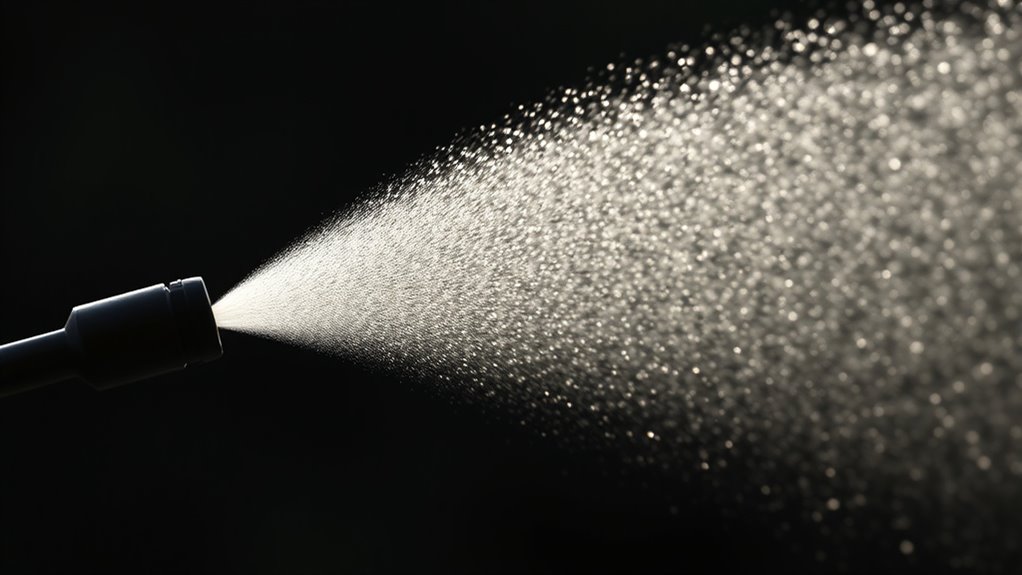
Have you ever wondered how distance and angle influence the way we perceive and measure the world around us? When it comes to spray patterns, whether you’re painting, gardening, or applying any liquid, understanding these simple geometric principles makes all the difference. The key lies in how distance from the target and the angle at which you hold the spray nozzle affect the coverage and precision of your application. By grasping these concepts, you can improve your technique and achieve more consistent, professional results.
Think about standing closer to a surface. When you’re near, the spray particles hit a smaller, more concentrated area. This results in a thicker coat, but it also increases the risk of drips or uneven coverage because the spray has less space to disperse. Conversely, stepping back spreads the spray over a larger area, creating a thinner, more even layer. This is useful when you want to cover broad surfaces quickly but requires careful control to avoid missing spots or creating drips due to excess coverage. The distance you keep from the target directly influences how much of the spray lands on the surface and how fine or coarse that spray appears.
Getting closer for thicker coverage; stepping back for even, wide spray.
Now, consider the angle at which you hold the spray nozzle. When the nozzle is perpendicular to the surface, the spray pattern hits the target evenly, giving you maximum control and uniform coverage. Tilting the nozzle changes the shape and distribution of the spray. For example, angling the nozzle away from the surface causes the spray to spread over a larger area but with less intensity, which might be desirable for delicate work or when applying a light coat. On the other hand, angling it toward the surface concentrates the spray, increasing the thickness of the coating but risking unevenness or runs if not managed carefully.
The interplay of distance and angle also influences the spray pattern’s shape. As you increase the distance, the spray particles tend to spread out more, creating a broader pattern. When you adjust the angle, you modify how the particles are directed, which can either focus or fan out the spray. Mastering these simple geometric relationships allows you to control the spray’s reach, coverage, and precision without complex calculations—just intuition and practice. Properly managing spray geometry and understanding how these factors interact can significantly enhance your application techniques. By paying attention to how both distance and angle interact, you can master the art of “perfect spray,” ensuring your work looks clean, efficient, and professional every time.
Frequently Asked Questions
How Does Paint Viscosity Affect Spray Accuracy?
Paint viscosity directly impacts your spray accuracy by influencing how smoothly and evenly the paint flows through your sprayer. If it’s too thick, you’ll experience sputtering, uneven coverage, and overspray, making it hard to control the spray pattern. Conversely, if it’s too thin, you risk runs, drips, and a lack of proper adhesion. To achieve precise, consistent results, you need the right viscosity suited for your spray equipment and project.
What Tools Assist in Maintaining Consistent Spray Angles?
You can use tools like spray angle guides, adjustable spray guns, and angle measurement devices to keep your spray angles consistent. These tools help you set and maintain the correct angle throughout your application, ensuring uniform coverage. A pro tip is to regularly check your tools for calibration and wear. This way, you’ll achieve a smooth, even finish and avoid overspray or uneven coatings.
How Does Environmental Wind Impact Spray Distance?
Environmental wind can substantially affect your spray distance by dispersing paint or other materials unpredictably. If the wind is strong, it pushes the spray away from your target, reducing accuracy and control. Conversely, a gentle breeze might cause uneven coverage. To maintain consistent distance, you should shield your work area from the wind with barriers or choose a calm day for spraying. Adjust your technique accordingly to compensate for wind effects.
Can Spray Patterns Be Adjusted for Different Surface Textures?
Yes, you can adjust spray patterns for different surface textures. To do this, change your spray distance, modify the nozzle or spray tip, and adjust the spray angle. For rough surfaces, use a wider pattern and closer distance to ensure proper coverage. For smooth surfaces, a narrower pattern from a farther distance works best. Experimenting with these adjustments helps you attain an even, professional finish tailored to each surface.
What Safety Precautions Are Recommended During Spraying?
You must wear protective gear every single time you spray—think of it as your armor against a paint explosion! Always use a mask to avoid inhaling fumes, goggles to protect your eyes from splatters, and gloves to keep your skin safe. Make sure proper ventilation, work in a well-ventilated area, and keep a fire extinguisher handy. Never rush; safety first keeps your spraying both effective and accident-free!
Conclusion
Just like a master archer aims with precision, understanding distance and angle lets you perfect your spray. When you apply these simple geometric principles, you reveal a world where accuracy becomes second nature—no magic needed, just knowledge. Remember, even Hercules needed a steady hand. So, trust these basics, stay focused, and watch your spray hit the mark every time. It’s all about the right angle and distance—your secret weapon for flawless results.
